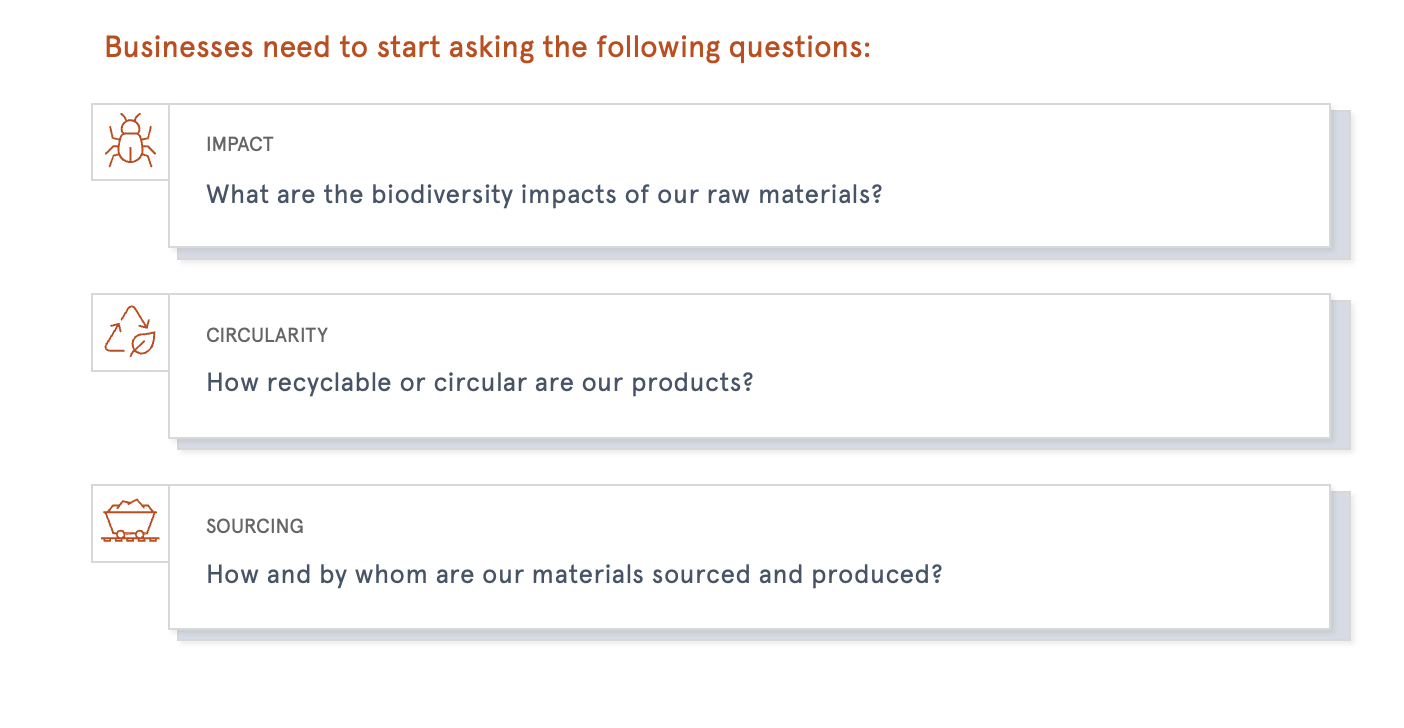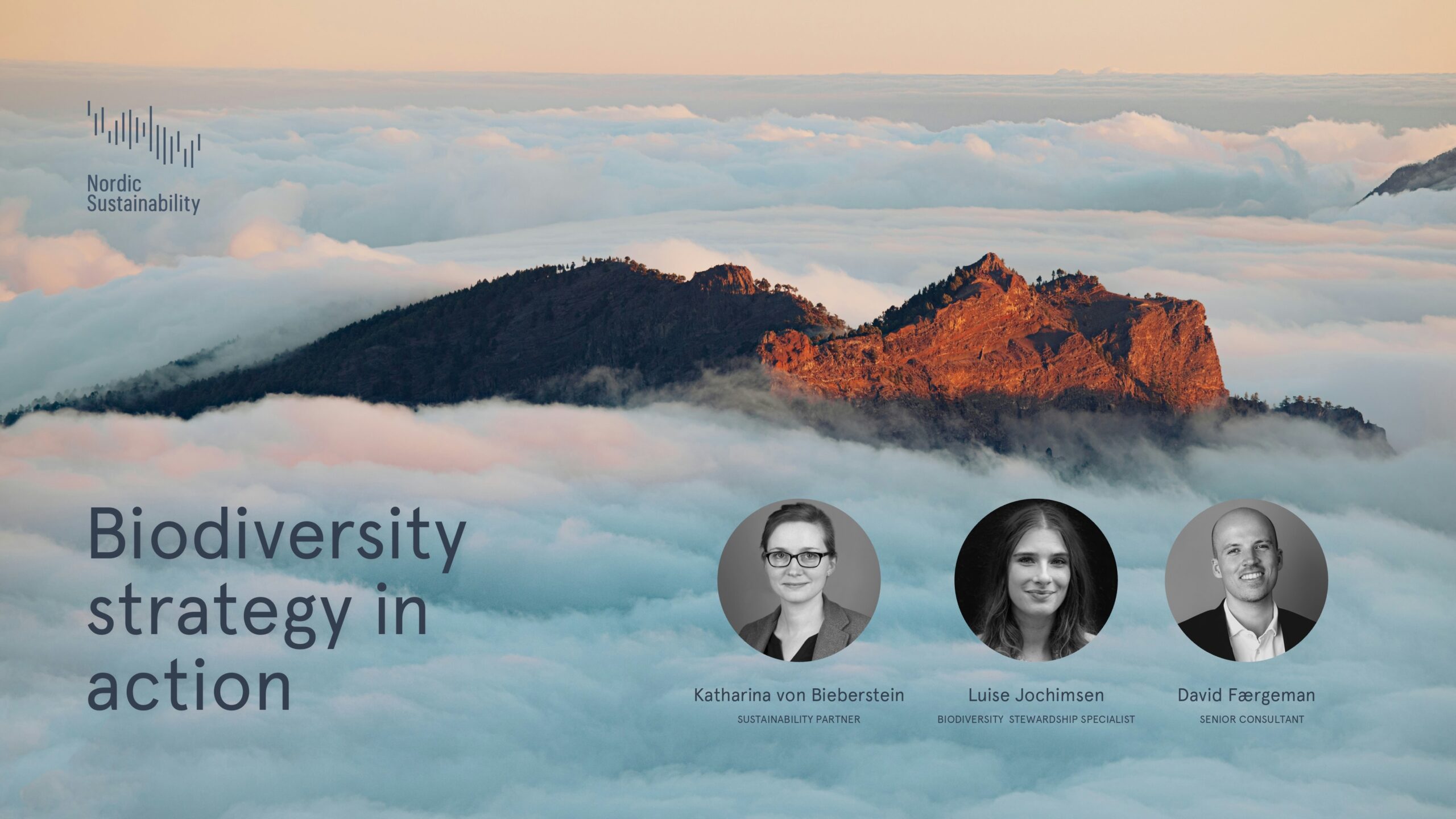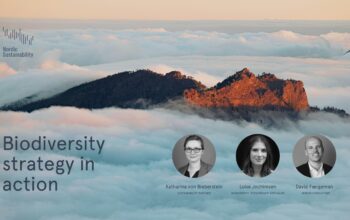
Businesses are increasingly recognising the close relationship between biodiversity and operational resilience. Unhealthy ecosystems affect supply chains, raw material availability and market stability, making biodiversity a matter of long-term business security. In this article, we discuss how your organisation can integrate biodiversity into its strategy to strengthen business resilience.
Material use is a strategic entry point for biodiversity action
Over the next decade, biodiversity loss and ecosystem collapse rank as the second-largest global risks, only surpassed by extreme weather events. This article dives into how material use can serve as a starting point for businesses to understand and reduce their biodiversity impact, especially in sectors where risks are less visible.
Businesses can address their impacts and develop a systematic strategy for working with nature by identifying biodiversity hotspots, areas where business activities have the most significant impact.
In sectors such as Food, Beverages & Alcohol, Materials, or Energy, biodiversity hotspots are often more evident, associated with deforestation, habitat destruction, or resource overexploitation. For many industries, however, these impacts can be less visible and harder to identify.
For those, focusing on material usage offers a strategic entry point. Four of the five drivers of biodiversity loss – land-use change, climate change, pollution, and overexploitation – are directly or indirectly linked to material consumption.
Start your journey with us.
Connect with our experts to map your company’s impact on nature, identify high-priority ideas, and build an ambitious, yet achievable strategy to reach your goals.
-> Senior ConsultantDavid Færgeman.
There are hidden biodiversity impacts in material use
Extraction and processing of natural resources account for more than 90% of biodiversity loss. Some businesses have clear biodiversity risks linked to raw material sourcing, while others may have less obvious, but equally significant, impacts.
For example, consider Company A, a textile manufacturer producing synthetic and natural fibre-based apparel. The textile industry heavily depends on raw materials like cotton, polyester, and dyes, each with well-documented environmental consequences such as deforestation, habitat destruction, and water pollution.
Now consider Company B, which manufactures long-lasting stainless steel drinking bottles. Unlike Company A, its biodiversity footprint is less immediately apparent. Further, it sources raw materials from the global market with little leverage over its supply chain.
Yet, upon closer analysis, Company B finds that stainless steel, its primary material, has significant biodiversity impacts due to land-use change from mining, high energy and water use in production, and associated carbon emissions.
From biodiversity assessment to action
For companies like Company B, reducing material usage is both a practical and strategic starting point for addressing biodiversity risks. This requires a full lifecycle perspective, examining raw material sourcing, production sites, product design, and end-of-life use.
Based on their assessment, Company B investigates several targeted actions:
- Upgrading sourcing structures to better understand the supply chain.
- Designing products more efficiently to minimize resource waste.
- Exploring material reuse or circular economy models.
- Optimizing production processes to reduce leftover scrap and energy consumption.
Switching to green steel emerges as a possible solution, but current supply constraints and high costs make it unfeasible. Instead, Company B turns to product design considering: “Could reducing bottle thickness from 4mm to 3mm maintain durability and temperature retention while cutting steel use by 25%?”
From there, additional operational questions follow:
- Can production waste be minimised?
- Can energy-intensive processes be optimised or powered by renewables via a Power Purchase Agreement (PPA)?
- Could Company B start to selectively purchase steel from suppliers with specific policies or certifications in place?
- Or can a take-back scheme be introduced, offering customers a discount on new bottles when returning old ones for recycling?
These types of questions move biodiversity from a high-level concern to concrete design and procurement decisions. While illustrative, these examples reflect real challenges businesses face and help ground practical decision-making.

Integrating biodiversity strengthens business resilience
As ecosystem services become more fragile, the cost and availability of natural resources are likely to be affected.
In the euro area alone, 72% of the 4.2 million non-financial corporations rely critically on ecosystem services, making them vulnerable to nature degradation. Working in symbiosis with our ecosystems enhances long-term business resilience by lowering supply chain risks, supporting compliance with emerging regulations, and opening opportunities for innovation and differentiation.
Advantages of embedding biodiversity in your business strategy include:
Resilience and risk reduction
- Reduce reliance on global supply chains, lowering vulnerability to disruptions.
- Lower sustainability risks, such as forced labour in supply chains.
Climate impact and resource efficiency
- Decrease emissions, supporting decarbonisation efforts and net-zero target meeting.
- Enhance long-term cost savings, as resource scarcity drives raw material prices higher.
Regulatory alignment
- Prepare for regulations as biodiversity-related reporting requirements expand (such as the EU’s Corporate Sustainability Reporting Directive (CSRD) and the Regulation on Deforestation-free Products (EUDR). Companies that address biodiversity early will be better positioned for compliance.
Market opportunities
- Innovate for market differentiation, businesses that embrace biodiversity-conscious practices can open new revenue streams, improve product appeal, and gain an edge in sustainability-driven markets.
Addressing global biodiversity loss requires industry collaboration and a shift in how businesses define value
To strategically and successfully address biodiversity impacts, a crucial shift in business thinking is required. Businesses must move beyond short-term cost considerations and begin evaluating the hidden externalities of material use.

These questions should form the foundation for a biodiversity strategy. And to turn this into action, businesses can focus on three areas:
- Expand the definition of value – Moving beyond traditional economic growth models to include natural capital in financial decision-making.
- Collaborate with suppliers and industry peers – Engaging suppliers on biodiversity commitments and joining industry-wide sustainability initiatives can increase influence and amplify positive impact.
- Engage with customers – Consumers are increasingly making purchasing decisions based on sustainability. Transparent communication on biodiversity efforts can enhance brand loyalty and customer trust.
This article has covered how your organisation can integrate biodiversity into its strategy to strengthen business resilience. Curious to know more about biodiversity action in practice?
Sign up for our webinar!

Join our upcoming webinar on April 24th of April featuring leading biodiversity experts Katharina von Bieberstein (VELUX), Luise Jochimsen (WWF) and the author of this article, David Færgeman (Nordic Sustainability).
-> Sign up here: https://biodiversity-strategy-webinar.eventbrite.dk




